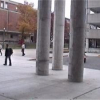Free Online Productivity Tools
i2Speak
i2Symbol
i2OCR
iTex2Img
iWeb2Print
iWeb2Shot
i2Type
iPdf2Split
iPdf2Merge
i2Bopomofo
i2Arabic
i2Style
i2Image
i2PDF
iLatex2Rtf
Sci2ools
97
Voted
CVPR
2008
IEEE
2008
IEEE
3D occlusion recovery using few cameras
We present a practical framework for detecting and modeling 3D static occlusions for wide-baseline, multi-camera scenarios where the number of cameras is small. The framework consists of an iterative learning procedure where at each frame the occlusion model is used to solve the voxel occupancy problem, and this solution is then used to update the occlusion model. Along with this iterative procedure, there are two contributions of the proposed work: (1) a novel energy function (which can be minimized via graph cuts) specifically designed for use in this procedure, and (2) an application that incorporates our probabilistic occlusion model into a 3D tracking system. Both qualitative and quantitative results of the proposed algorithm and its incorporation with a 3D tracker are presented for support.
Computer Vision | CVPR 2008 | Iterative Learning Procedure | Iterative Procedure | Occlusion Model | Probabilistic Occlusion Model | Voxel Occupancy Problem |
Related Content
| Added | 12 Oct 2009 |
| Updated | 28 Oct 2009 |
| Type | Conference |
| Year | 2008 |
| Where | CVPR |
| Authors | Mark A. Keck, James W. Davis |
Comments (0)

